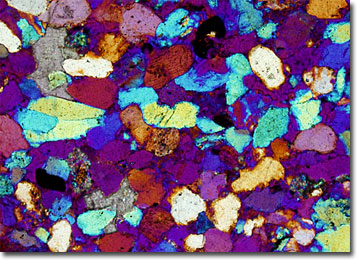Polarized Light Microscopy Digital Image Gallery
Gray Sandstone
Sandstone is the second most common sedimentary rock and comprises a significant portion of the Earth’s crust. Primarily composed of grains of sand cemented together by a variety of materials, such as clay, calcium carbonate, silica, or iron oxides, sandstones have played an important role in helping scientists develop an understanding of the geologic history of the planet.

In its purest form, sandstone is glassy and white in color, but the material is more typically found in shades of brown, yellow, red, and gray. The color of the rock is determined by the type of minerals it contains, as well as the characteristics of the material that bonds them together. The presence of iron oxide, for instance, results in a yellow, orange, or reddish-brown hue, while significant amounts of potassium feldspar impart a pinkish tint to the rock. The occurrence of gray sandstone is typically a sign that the rock contains calcite cement.
Due to their resistance to erosion, sandstones are extremely important to the topography of the Earth. Not only do they underlie expansive plains and plateaus, but they also form the foundational structure of the Appalachians and other notable mountain ranges. This same quality makes the rock highly desirable for industrial and construction purposes. Easy to cut and relatively lightweight compared to many other building materials, sandstone is a particularly popular choice for home exteriors, retaining walls, walkways, and landscaping. The rock is also commonly utilized along rivers and lakes as an environmental control guarding against flooding and erosion.
